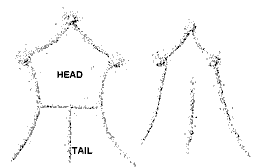 |
Science Frontiers ONLINE No. 96: Nov-Dec 1994 |
|
|
The "kites" or "keyhole" structures of the middle east
Thousands of walled structures decorate the deserts and plains of the Middle East. Most are V-shaped terminating in a cul de sac studded with large rock piles. (See illustration.) Most of the wall arms are 300-3,000 meters long. They are constructed of basalt rocks from ancient lava flows. Artifacts found nearby suggest ages of at least 7,000 years. Younger, but very similar, structures have been found in Central Asia.

|
(Anderson, Ian; "Prehistoric Prey Met Death through a Keyhole," New Scientist, p. 15, September 24, 1994.)
Comment. Some kite walls extend 30 kilometers (18 miles) and represent a considerable investment of labor. See also: Field, Henry; "Early Man in North Arabia," Natural History, 29:32, 1929. Of course, aliens could have herded ancient humans into the kites. Remember the classic sci-fi story: "To Serve Man"?